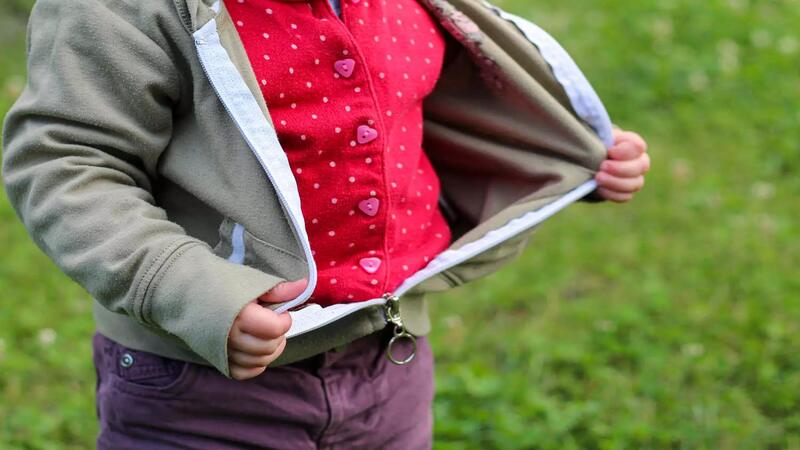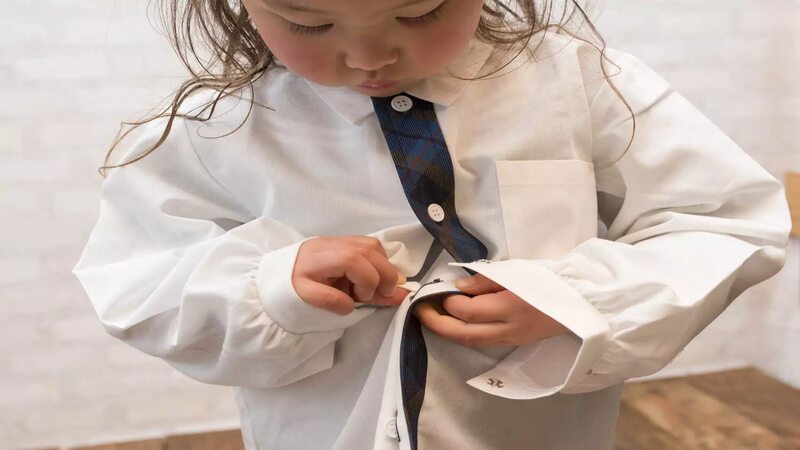
Toddlerhood comes with exposure and exploration to a flurry of activities. You can see toddlers doing lots of things with so much confidence – be it walking, running, dancing, talking and even being impeccably potty-trained. Dressing and undressing by themself is another important development activity during this stage. Clinging on to their favorite dress or removing the one they do not like will become common to you from now on.
Being able to dress is a major physical milestone. This is because dressing and undressing require a lot of coordination between hands and legs and demands good dexterity and finger movements. Dressing and undressing independently is also an emotional milestone for toddlers as now they can satisfy their need to wear a fur coat on a hot afternoon or roam around naked in chilly winter.
When Will my Toddler be Able to Dress on Their Own?
Being able to dress on their own is a very slow process that toddlers learn with time. It will take years for your kid to properly dress without your assistance. But they will start showing the signs of this gradual process as soon as they hit their first year. Here are some developmental signs for dressing that you can see in your toddler (1)-
1 Year

Toddlers with the first onset of toddlerhood from around 1 year of age can start showing great interest in their clothes. They are still too small to do anything helpful though. But they might lift their hands to put on the sleeve and stick their legs out to put the shoes (2).
1.5 Years

At around 17 months a toddler may show signs of removing their socks and diapers on their own when they feel uncomfortable. They can throw away or put on a loose-fitting hat, remove their shoes, and try to pull off their socks. However, they are still not able to dress themselves yet.
2-3 Years

The motor skills of toddlers develop exponentially by now and during the period between their second and third birthday, they will learn to do many tricks using their fingers (3). They can do activities like zipping and unzipping their jacket, putting shoes on their own, wearing a hat, and so on. By 32 months, they may show interest in trying to dress themselves. But will require help from you to properly do the job.
These ages are only indicative and you need not panic if your child does not do something meant for their age.
How to Encourage my Toddler to Dress And Undress by Themself?
The encouragement, appreciation, and timely assistance of parents help toddler’s overall development (4). Here are some ways to encourage your child to get interested in self-dressing-
1. Practice Makes Perfect

Give toddlers plenty of opportunities to dress up. You can give them dolls or teddy bears and a variety of slip-on and other clothes and shoes and let them play with all these. You can also give them a dress-up kit with papa’s big shirts, mama’s dupatta, and so on. All of these will spark their interest in wanting to dress by themselves.
2. Dressing Before Sleep

The dress change before sleep time is a good time to start practicing. This is because in the mornings you can be in a hurry and your toddler can be sleepy, hungry, and restless. That leaves no room for leisurely exploration. However, in the evening, it is more comforting for both you and your toddler to spend some time pulling on the pajamas correctly.
3. Follow The Same Rule
To help your toddler learn it right, follow the same method of dressing regularly. Always put on clothes the same way that you have followed from the beginning. And do this consistently. This will help your toddler to get used to the movements associated with dressing naturally.
4. Be Patient

Do things gradually. Let your toddler lead the way. Do not pressure your kid to do something out of frustration or peer pressure. It does not matter if your friend’s similar-aged toddler can pull off the socks and yours cannot. You can, however, help the toddler’s self-dressing confidence by pulling off most of the socks yourself and encouraging them to do the last bit on their own.
5. Use Easy-to-Wear Clothes to Start With

Start with clothes that are easy to put on. Shoes with velcro, pull-on frocks, trousers with elastic bands (as opposed to buttons and zips) etc. These easy-to-wear clothes will help your toddler learn to dress or undress initially.
6. Arrange The Clothes in Order

Once your toddler gets bigger and accustomed to some self-dressing skills, you can arrange clothes one by one to enhance their understanding of the right order of clothing. You can follow the order of undergarments first, then bottoms and tops, and keep the socks and shoes for the last.
What to Expect When Your Toddler Dresses on Their Own?

You can expect lots of funny moments when your toddler first learns to dress independently. You may see your toddler wearing pants from the head as if it is a shirt. Wearing tops backwards or pants inside out is going to be a regular view for you.
You may also have to deal with complaints and demands for new dresses more frequently. It will not be a new thing for you to see heaps of clothes outside your toddler’s wardrobe. Deal with these situations calmly.
Show warmth and appreciation to toddlers for each new initiative or effort they take irrespective of the mistakes to boost their self-esteem (5). You can also instruct them on the right way of clothing but do not force your toddler, instead let them be creative with their dressing style.
How Dressing And Undressing Help in Toddler Development?

Dressing and undressing skills help in the motor development and cognitive development of toddlers. Different types of garments demand different methods to wear or remove them. This will enhance the mental and physical abilities of your toddler when they gradually learn and successfully do it individually. Dressing and undressing help in toddler development in ways including-
Gross Motor Development
Taking off the pants requires bending, lifting legs and pulling the pants using hands. All these activities happen due to gross motor development and regular practice of these activities further initiates the refinement of gross motor skills (6).
Fine Motor Development
Using zippers, buttons, or pulling shoe lace or velcro, all of these dressing skills require fine motor development (7)
Cognitive Development
Dressing and undressing also aid in cognitive development as toddlers get to learn about the order of dressing through it. They can also learn about seasonal, environmental, and cultural factors that regulate dressing which will improve their cognition.
Social Development
The choice of dresses and the appreciation and praise that they get due to their appearance can benefit their social development (8).
Emotional Development
Dressing and undressing can facilitate the emotional development of toddlers as instead of completely depending on the parents they can now choose their dress or remove it whenever they feel uneasy. This can satisfy their emotional needs important for their overall development and well-being (9).
Tips to Help Your Toddler Become Independent With Dressing And Undressing

Now that you know how important it is to let your toddler become independent with dressing, it is your time to practice it. Here are some tips that you can follow-
- Give easy access to clothes to your toddler. Put the wardrobe unlocked to let your toddler try different dresses.
- Choose loose-fitting clothes that they can easily wear or remove.
- You can take V-neck t-shirts instead of the ones with buttons and elastic waist pants instead of the ones with zippers.
- Let them wear slippers or shoes with velcro in place of sneakers with shoelaces.
- Use simple words to demonstrate how to wear each piece of clothing.
- Use the tags to show which side of the cloth should be inside. Play dress-up games with your toddler to encourage their dressing skills.
- Praise your toddler for the attempt of self-dressing and encourage to do it again next time.
When to Worry?

If your child is not able to dress or undress by the time of 30 months, ask yourself whether you are giving them enough opportunities. If you feel that there might be issues related to strength or dexterity then seek your pediatrician’s advice and do the necessary tests if required.
The dressing and undressing skills of toddlers are linked with their sensory perception, motor development, and physical strength. Successful accomplishment of this developmental milestone will boost your toddler’s self-confidence and social development. You need to aid your toddler in attaining this skill with regular practice and patience. Most importantly, enjoy these funny moments with your toddler as they are precious.
FAQ’s
1. At What Age do Toddlers Undress Themselves?
In general, toddlers can remove at least a few of their clothing items by the time they reach 2 years of age. This is a general perspective, your toddler can do it months earlier or may take a few more months. There is no need to worry about delay if your toddler is otherwise healthy and showing developmental improvements.
2. Should I Let my Toddler Dress on Their Own?
Yes, you should let your toddler dress on their own. This is a vital developmental milestone that can improve their sense of independence and self-confidence. Their achievements in successful dressing will satisfy their emotional needs for praise and social recognition. The dressing and undressing activities will improve their gross and fine motor development and make them perfectionists in doing the job.
References
- CHOC Children’s Hospital of Orange County, |Information adapted from “Developmental Pre‐Dressing Checklist”‐ 1983 by Communication Skill Builders, Inc – https://www.choc.org/wp/wp-content/uploads/2014/11/Rehab-Developmental-dressing-skills.pdf
- Sevan S. Misirliyan; Annie P. Boehning; Manan Shah Wayne State University School of Medicine, California State University, Bakersfield, Rutgers University – https://www.ncbi.nlm.nih.gov/books/NBK557518/#
- Department Of Education – https://help-for-early-years-providers.education.gov.uk/physical-development/fine-motor-skills
- National Academies of Sciences, Engineering, and Medicine; Division of Behavioral and Social Sciences and Education; Board on Children, Youth, and Families; Committee on Supporting the Parents of Young Children; Breiner H, Ford M, Gadsden VL, editors. Parenting Matters: Supporting Parents of Children Ages 0-8. Washington (DC): National Academies Press – https://www.ncbi.nlm.nih.gov/books/NBK402020/#
- Krauss S, Orth U, Robins RW. Family environment and self-esteem development: A longitudinal study from age 10 to 16. J Pers Soc Psychol. 2020 Aug;119(2):457-478 – https://www.ncbi.nlm.nih.gov/pmc/articles/PMC7080605/#
- Sutapa P, Pratama KW, Rosly MM, Ali SKS, Karakauki M. Improving Motor Skills in Early Childhood through Goal-Oriented Play Activity. Children (Basel). 2021 Nov 2;8(11):994 – https://www.ncbi.nlm.nih.gov/pmc/articles/PMC8625902/#
- National Association for the Education of Young Children – https://www.naeyc.org/our-work/families/help-your-child-build-fine-motor-skills#
- Department of Lifelong Education, Advancement, and Potential – https://www.michigan.gov/mikidsmatter/parents/pre-k/social#
- Thümmler R, Engel EM, Bartz J. Strengthening Emotional Development and Emotion Regulation in Childhood-As a Key Task in Early Childhood Education. Int J Environ Res Public Health. 2022 Mar 27;19(7):3978 – https://pmc.ncbi.nlm.nih.gov/articles/PMC8998041/#
